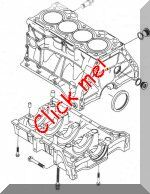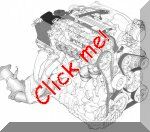
Welcome, from sunny Australia!
More on the Honda V-TEC S2000 engine

More on the Honda V-TEC S2000 engine
I know that this page is intended to be a comparison between the Toyota VVT and the Honda V-TEC, but I've got a few more pictures of the Honda engine, so I'll write a bit more about it. ;) I only hope that my Toyota fans aren't too upset!
The engine is truly a product of Honda's Formula One experience.


In the above picture you can see a number
of interesting details -
- Coil-over-plug ignition. Each sparkplug
has it's own coil, thus letting each of those coils fully saturate
(electrically & magnetically) before firing.
- The cams are driven by a 'morse hy-vo'
chain. This takes slightly more power to drive than a belt drive, but it
usually more accurate. (and slightly noisier)
- The cams are driven by a central idler
gear, and so spin in opposite directions.
- The cam wheels are made from two pieces so
that the rear piece can be turned a small amount to eliminate any
back-lash.
- The oil pump is driven by a small chain,
going down into the sump. Not sure why they've done this, as the more
common 'pump sitting around the crank' type pump would seem to be more
efficient and reliable.
- 4-2-1 extractors. Gives a better spread of
power than the 4-1 type.
- The water pump is driven at crank speed.
(the water pump pulley is the middle one of the right hand column of
three.) A lot of engines have the water pump driven faster than engine
speed when they don't need to, thus wasting power.
- Tiny little springs to keep the inner
'high power' cam followers working on the cam lobe when not engaged, and
I guess to make the effective spring pressure and rate higher when V-TEC
is working to allow very high revs.
Back
to the VVT Vs V-TEC page
Read about
the latest Toyota VVTL-i system
Back to the Index page
Page & contents where applicable © Bill Sherwood